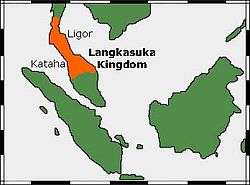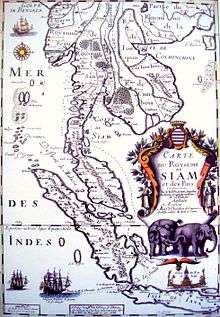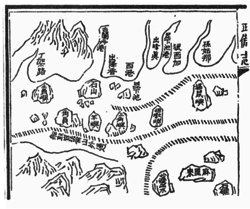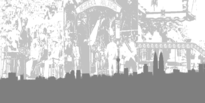Langkasuka
| Langkasuka | ||||||||
| ||||||||
 A suggestion of the reach of the kingdom of Langkasuka. While many consider Langkasuka to be located on the East coast of the Malay peninsula, some argued for a kingdom that extended from the East to the West coast. Ligor refers to Nakhon Si Thammarat and Kataha is Kedah. | ||||||||
| Capital | Unknown | |||||||
| Languages | Old Malay | |||||||
| Religion | Hindu-Buddhist | |||||||
| Government | Monarchy | |||||||
| Raja | Merong Mahawangsa | |||||||
| Bhagadatta | ||||||||
| History | ||||||||
| • | Established | 2nd century | ||||||
| • | Disestablished | 15th century | ||||||
| ||||||||
| Today part of | | |||||||
Langkasuka (langkha Sanskrit for "resplendent land" -sukkha for "bliss") was an ancient Hindu-Buddhist Malay kingdom located in the Malay Peninsula.[1] Another possible source of its name could be the combination of (-langkha Sanskrit for "resplendent land" – and Ashoka in tribute to the legendary Mauryan Hindu warrior king who eventually became a pacifist after embracing the ideals espoused in Buddhism), the ancient kingdoms of the Malay Isthmus – Langkasuka having been one of them – believed by some scholars to have been first founded or rebuilt by emissaries or descendants of Ashoka from Magadha in India.
The kingdom, along with Old Kedah, is probably among the earliest kingdoms founded on the Malay Peninsula. The exact location of the kingdom is of some debate, but archaeological discoveries at Yarang near Pattani, Thailand suggest a probable location. The kingdom is believed to have been founded in the 2nd century.
Historical records
Part of a series on the |
|---|
| History of Thailand |
 |
|
Legendary Suvarnabhumi Central Thailand Dvaravati Lavo Supannabhum Northern Thailand Singhanavati Ngoenyang Hariphunchai Southern Thailand Pan Pan Raktamaritika Langkasuka Srivijaya Tambralinga Nakhon Si Thammarat Sultanate of Pattani Kedah Sultanate |
| History |
|
Sukhothai Kingdom Ayutthaya Kingdom Thonburi Kingdom Rattanakosin Kingdom Military period Democratic period |
|
Regional history |
|
|
Historical records are sparse. The earliest and most detailed description of the kingdom comes from the Chinese Liang Dynasty (502-557) record Liangshu, which refers to the kingdom of "Lang-ya-xiu" (Chinese: 狼牙脩, Lang-gga-siu in Hokkien) founded in the 2nd century AD. According to Liangshu, "Lang-ya-xiu" or Langkasuka was thirty days' journey from east to west, and twenty from north to south, 24,000 li in distance from Guangzhou. It mentions that Aloeswood (Aquilaria) and camphor were abundant in the kingdom, and its capital was described as being surrounded by walls to form a city with double gates, towers and pavilions. Both men and women in Langkasuka were said to wear sarongs with their torsos bare and their hair loose, although the king and senior officials covered their shoulders with cloth and wore gold earrings and belts of gold cord. Women of high status wrapped themselves in cloth and wore jeweled girdles.[2] It gives further information on some of its kings and also related a story on a succession:
When the king goes forth he rides upon an elephant. He is accompanied by banners, fly-whisks, flags and drums and he is shaded with a white parasol. The soldiers of his guard are well-appointed. The inhabitants of the country say that their state was founded more than four hundred years ago. Subsequently the descendants became weaker, but in the king's household there was a man of virtue to whom the populace turned. When the king heard of this he imprisoned this man, but his chains snapped unaccountably. The king took him for a supernatural being and, not daring to injure him, exiled him from the country, where upon he fled to India. The king of India gave him his eldest daughter in marriage. Not long afterwards, when the king of Langkasuka died, the chief ministers welcomed back the exile and made him king.
This king then ruled for 20 years. He was succeeded by his son, King Bhagadatta, who sent the first ambassadorial mission to China in 515.[5][6]
The transcription of the kingdom's name in Chinese records changed over time. In the late seventh century, the Buddhist monk Yi Jing mentioned encountering three Chinese monks who lived in a place named Lang-jia-shu (郎伽戍).[5]
A Song Dynasty work Zhu fan zhi (published in 1225) gives a description of the country of Ling-ya-si-jia (凌牙斯加). It mentions that its people cut their hair and wrapped themselves in a piece of cloth, its products included elephant tusks, rhinoceros horns, types of wood and camphor, and their merchants traded in wine, rice, silk and porcelain. It also says that the country paid tribute to a country named Sanfoqi which is often interpreted to be Srivijaya.[7][8]
Langkasuka was known as "Long-ya-xi-jiao" (龍牙犀角) in Daoyi Zhilüe from the Yuan Dynasty (1279–1368);[9] and "Lang-xi-jia" (狼西加) during the Ming Dynasty (1368–1644), as marked in the Mao Kun map of Admiral Zheng He .[10]
The country was named "Langkasuka" in the Malay text Hikayat Merong Mahawangsa, and was referred to as "Lengkasuka" in the Javanese poem Nagarakretagama.[1] Tamil sources name "Ilangasoka" as one of Rajendra Chola's conquests in his expedition against the Srivijaya empire. It was described as a kingdom that was "undaunted in fierce battles". Thai sources made no reference to Langkasuka, but Pattani was identified as one of the twelve Naksat cities under the influence of Nakhon Si Thammarat in Thai chronicles.[11]
Outline of Langkasuka's history
A brief outline of the history of Langkasuka can be determined from the limited historical records available. The kingdom is thought to have been founded some time early in the 2nd century AD. It then underwent a period of decline due to the expansion of Funan in the early 3rd century. In the 6th century it experienced a resurgence and began to send emissaries to China. King Bhagadatta first established relations with China in 515 AD, with further embassies sent in 523, 531 and 568.[5] By the 8th century it had probably come under the control of the rising Srivijaya empire.[12] In 1025 it was attacked by the armies of King Rajendra Chola in his campaign against Srivijaya. In the 12th century Langkasuka was a tributary to Srivijaya, and around the 15th century it was replaced by the Pattani Kingdom.
Location

Chinese and Arab sources placed the ancient kingdom on the east coast of the Malay Peninsula. The New Book of Tang mentioned that Langkasuka bordered on Pan Pan, and a map in the Ming Dynasty military treatise Wubei Zhi located it south of Songkla near Pattani River.[5] A 15th century Arab text similarly placed the kingdom south of Songkla. The only contradictory information came from a later Malay text Hikayat Marong Mahawangsa which placed it on the west coast as the predecessor of modern Kedah, although its sovereign had some association with Pattani.[13] Chinese, Arab and Indian sources all considered Kedah and Langkasuka to be separate geographical entities. The Javanese poem Nagarakretagama placed it north of Saiburi, however it appeared to imply that it was originally located on the west coast but was transferred later to the east.[2]
In 1961, taking account of the various sources, the geographer and historian Paul Wheatley concluded that Langkasuka should be located near to the modern town of Pattani.[14] French archaeologist and historian Michel Jacq-Hergoualc'h also suggested that Langkasuka may be located around the former estuary of the Pattani River near Yarang. He also suggested that whole area between Pattani, Saiburi and Yala was part of Langkasuka.[10] Modern archaeological explorations have uncovered ruins near Yarang, a village fifteen kilometers south of Pattani, which may be of the city described in Liangshu.[15] The city was located inland 10 miles from the coast and connected to the rivers leading to the sea via canals.[12] Silting of the waterways may have led to its decline.
Archaeology

Several archaeological expeditions were conducted in the 1960s to locate Langkasuka following the suggestion by Paul Wheatley of its likely location. In 1963, Stewart Wavell led a Cambridge expedition to locate Langkasuka and Tambralinga and the details of this expedition are described in The Naga King's Daughter.
An archaeological investigation of the Yarang area began in 1989 by The Fine Arts Department of Thailand.[15] The majority the ruins were clustered in the vicinity of a hamlet called Ban Wat, and may have formed the nucleus of the city. Others were scattered further to the North at Ban Jalæ, and a couple more at Ban Prawæ. The excavations found various Buddhist structures and objects including votice tablets and sculptures, indicating a strong Buddhist presence in the kingdom. Objects related to Hindu worship were also found.
Many Chinese and Arab coins made of bronze have been found in the region, an indication of the commercial activity of the kingdom. Two silver Sassanid coins have also been found.[16]
Langkasuka in popular culture
In 1968, Malay film called Raja Bersiong or Fanged King directed by Jamil Sulong was made from the initiative of Malaysia's Prime Minister Tunku Abdul Rahman. A Thai movie entitled Queen of Pattani or Queens of Langkasuka, directed by Nonzee Nimibutr and loosely based on a south Pattani myth, was released in 2008.
A 2011 Malay movie entitled The Malay Chronicles: Bloodlines was directed by Yusry Abdul Halim. The film is loosely based the origin of Merong Mahawangsa, the first King of Langkasuka.
See also
References
- 1 2 Guy, John (2014). Lost Kingdoms: Hindu-Buddhist Sculpture of Early Southeast Asia. Yale University Press. pp. 28–29. ISBN 978-0300204377.
- 1 2 Keat Gin Ooi, ed. (2004). Southeast Asia: A Historical Encyclopedia, from Angkor Wat to East Timor, Volume 1. ABC-CLIO. pp. 764–765. ISBN 978-1576077702.
- ↑ "Langkasuka". Sejarah Melayu.
- ↑ 梁書/卷54 Liangshu, Chapter 54. Original text of the entry on Langkasuka in Liangshu: 狼牙脩國,在南海中。其界東西三十日行,南北二十日行,去廣州二萬四千里。土氣物產與扶南略同,偏多𥴈沉婆律香等。其俗男女皆袒而被髮,以吉貝爲干縵。其王及貴臣乃加雲霞布覆胛,以金繩爲絡帶,金鐶貫耳。女子則被布,以瓔珞繞身。其國累磚爲城,重門樓閣。王出乘象,有幡毦旗鼓,罩白蓋,兵衛甚設。國人說,立國以來四百餘年,後嗣衰弱,王族有賢者,國人歸之。王聞知,乃加囚執,其鏁無故自斷,王以爲神,因不敢害,乃斥逐出境,遂奔天竺,天竺妻以長女。俄而狼牙王死,大臣迎還爲王。二十餘年死,子婆伽達多立。天監十四年,遣使阿撤多奉表曰:「大吉天子足下:離淫怒癡,哀愍衆生,慈心無量。端嚴相好,身光明朗,如水中月,普照十方。眉間白毫,其白如雪,其色照曜,亦如月光。諸天善神之所供養,以垂正法寶,梵行衆增,莊嚴都邑。城閣高峻,如乾陁山。樓觀羅列,道途平正。人民熾盛,快樂安穩。著種種衣,猶如天服。於一切國,爲極尊勝。天王愍念羣生,民人安樂,慈心深廣,律儀清淨,正法化治,供養三寶,名稱宣揚,佈滿世界,百姓樂見,如月初生。譬如梵王,世界之主,人天一切,莫不歸依。敬禮大吉天子足下,猶如現前,忝承先業,慶嘉無量。今遣使問訊大意。欲自往,復畏大海風波不達。今奉薄獻,願大家曲垂領納。」
- 1 2 3 4 Michel Jacq-Hergoualc'h. The Malay Peninsula: Crossroads of the Maritime Silk-Road (100 BC-1300 AD). Victoria Hobson (translator). Brill. pp. 162–163. ISBN 9789004119734.
- ↑ Coedès, George (1968). Walter F. Vella, ed. The Indianized States of Southeast Asia. trans.Susan Brown Cowing. University of Hawaii Press. pp. 51, 77–78. ISBN 978-0-8248-0368-1.
- ↑ Geoff Wade (30 April 2013). Patrick Jory, ed. Ghosts of the Past in Southern Thailand: Essays on the History and Histiography of Patani. NUS Press. pp. 60–61. ISBN 978-9971696351.
- ↑ "《諸蕃志卷上》". Original text: 凌牙斯國,自單馬令風帆六晝夜可到,亦有陸程。地主纏縵跣足;國人剪發,亦纏縵。地產象牙、犀角、速暫番、生香、腦子。番商興販,用酒、米、荷池、纈絹、甆器等為貨;各先以此等物准金銀,然後打博。如酒一墱,准銀一兩、准金二錢;米二墱准銀一兩,十墱准金一兩之類。歲貢三佛齊國。
- ↑ "島夷誌略". Original text: 峯頂內平而外聳,民環居之,如蟻附坡。厥田下等。氣候半熱。俗厚。男女椎髻,齒白,繫麻逸布。俗以結親為重。親戚之長者一日不見面,必携酒持物以問勞之。為長夜之飮,不見其醉。民煮海為鹽,釀秫為酒。有酋長。地產沈香,冠於諸番。次鶴頂、降眞、蜜糖、黃熟香頭。貿易之貸,用土印布、八都刺布、靑白花碗之屬。
- 1 2 Geoff Wade (30 April 2013). Patrick Jory, ed. Ghosts of the Past in Southern Thailand: Essays on the History and Histiography of Patani. NUS Press. pp. 62–63. ISBN 978-9971696351.
- ↑ M.C. Chand Chirayu Rajani. "Background To The Sri Vijaya Story-Part I" (PDF).
- 1 2 Dougald J. W. O'Reilly (2006). Early Civilizations of Southeast Asia. Altamira Press. pp. 53–54. ISBN 978-0759102798.
- ↑ Michel Jacq-Hergoualc'h. The Malay Peninsula: Crossroads of the Maritime Silk-Road (100 BC-1300 AD). Victoria Hobson (translator). Brill. pp. 164–166. ISBN 9789004119734.
- ↑ Paul Wheatley (1961). The Golden Khersonese. Studies in the Historical Geography of the Malay Peninsula before AD 1500. University of Malaya Press.
- 1 2 Michel Jacq-Hergoualc'h. The Malay Peninsula: Crossroads of the Maritime Silk-Road (100 BC-1300 AD). Victoria Hobson (translator). Brill. pp. 166–175. ISBN 9789004119734.
- ↑ Michel Jacq-Hergoualc'h. The Malay Peninsula: Crossroads of the Maritime Silk-Road (100 BC-1300 AD). Victoria Hobson (translator). Brill. p. 191. ISBN 9789004119734.
